I honestly never expected that someone would propose such a fantastic urban housing project in our core in my lifetime. But I really never expected that it would be my city administration that would turn it down.
By Jason Leach
Published March 20, 2018
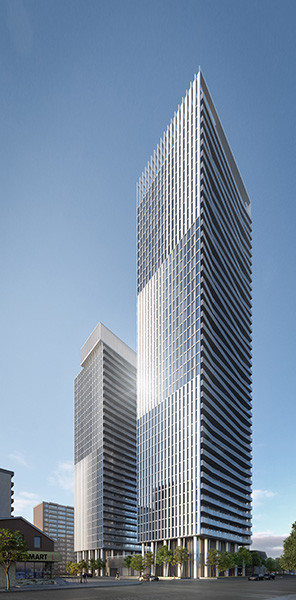
Rendering of Television City proposed development (Image Credit: Lamb Development Corp.)
I never thought I would have either the opportunity or the need to do this, but I need to state my support for the new housing project proposed in our downtown core on the CHCH site.
First of all, we need more housing in this city. Period. It gets tiring to read local development news and see City Hall constantly opposing or trying to shorten new urban development projects. Urban cities either grow or stagnate.
We have sprawled across the countryside for decades and are already paying a steep price for the poor planning: high taxes, way too many kilometres of roads we can't afford to maintain, and a hollowed-out central city.
As a taxpayer living in one of the highest-taxed cities in Ontario, I want many more $300 million, 600-unit investments in my downtown core. I welcome more resident ratepayers sharing the cost of running this city without having to build miles of new suburban roads.
More housing will also help our affordability problems. Anyone who complains about affordability can't in clear conscience turn down an additional supply of homes. And that's what these are: homes for people who want to live in our city.
Perhaps the most important fact of all surrounding new investment in our core can be found by looking at the older high-rises that were built during the last building boom downtown in the 1970s. Every building is full of residents, most have waiting lists, and the prices to purchase or rent are much cheaper than detached or semi-detached street level housing in Hamilton.
I have looked through the letters of opposition to this project (very few considering over a thousand notices went out) and of the ten letters that had a mailing address on them, six are from very nice condo buildings nearby - Bentley Place, Village Hill and Core Lofts. Three are from home owners and one is from a renter.
It's frustrating to see people who already have homes in our city trying to prevent other people from moving in. This is one of the biggest problems underway in Hamilton today: people who already own their nice luxury condo or Victorian home trying to block others from moving into their neighbourhood.
Hamilton's lower city population is 25,000 people fewer today than it was in 1971. I purchased my home in the downtown core with the belief that City Hall wanted to reverse that decline and revitalize the core.
I have long hoped that we would add a hundred thousand people to the core, not keep it depressed and with a shrunken population. I would have invested elsewhere had I known my civic administration is happy with the the economically stagnant status quo.
In the vibrant downtown of a major city, there is no such thing as "over-intensification" of a site. This concept is a peculiar Hamilton thing because we reflexively oppose anything more dense than single-family sprawl neighbourhoods.
The neighbourhood around this development is already full of high-rise buildings. The staff report conveniently omits the fact that one block from Television City there is a 28-storey and a soon-to-be-finished 32-storey building.
Why are a few homes on Wesanford taking precedent over the existing tall-building character of the neighbourhood? This would be like the ten-storey building on Rymal near Upper Wentworth now taking precedent every time a new home is proposed in that part of the city.
Here's the thing: cities grow larger over time. The idea of a new building needing to match the buildings next door is a recipe for stagnation. Consider the following:
The Pigott Building, Hamilton's first skyscraper, was far taller than anything else around it when it was built.
When City Hall was built, it was like a spaceship plopped into an old Victorian downtown. Now it's a protected heritage landmark.
The famous Hambly House on Longwood Road North doesn't match the old brick bungalows that surround it on all sides.
The Red Hill Valley Parkway certainly didn't match the trees and river surrounding it.
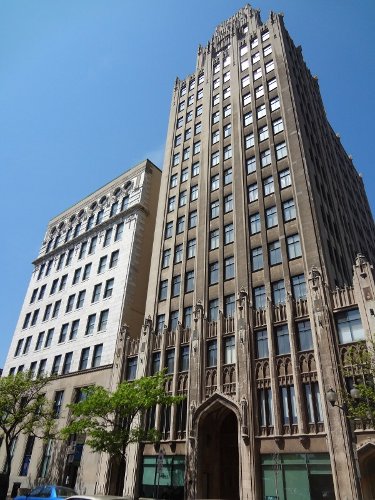
Pigott Building (RTH file photo)
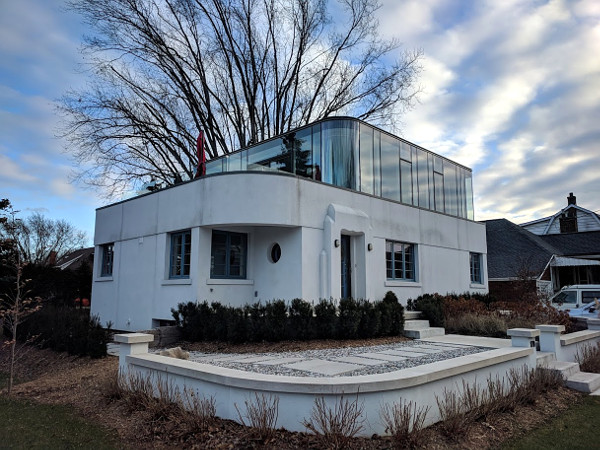
Hambly House on Longwood Road North (RTH file photo)
In none of those cases was there a successful argument that the new development should not be allowed because it didn't match the existing neighbourhood character.
Nothing will ever be built again if we honestly adopt this notion of matching to the current conditions next door. Even suburban homes with two-car garages don't match the grassy farmers fields next door.
As the staff report points out, this project conforms with the most important planning boxes: the Regional Growth Plan (Places to Grow), the Provincial Policy Statement, and the City's Official Plan. It is transit-oriented, pedestrian- and bike-friendly, mixed use, adds new residents, and has a variety of units from studios right through to three-bedrooms.
We need to address the Escarpment red herring. Buildings that are taller than the escarpment have already existed for decades and nobody noticed or cared. This proposed building is shorter than our tallest building, which was built 45 years ago. Are we really 'ambitious' or 'unstoppable'? Or are we going backwards?
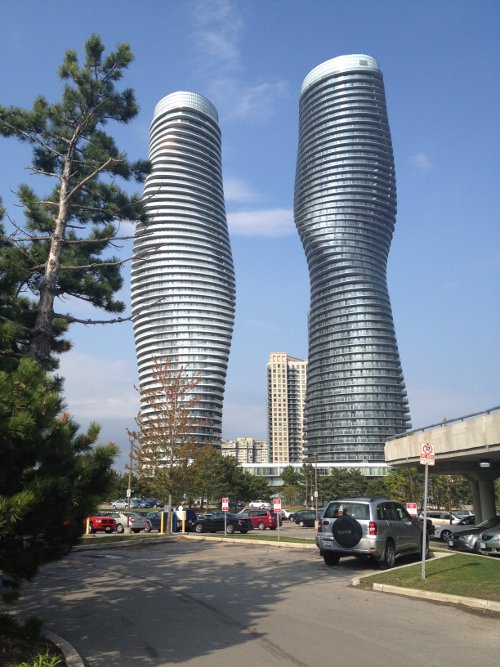
Absolute World, Mississauga, at 56 and 50 storeys (RTH file photo)
Most cities crave for a new tallest building to show that they're alive and building a modern city. Mississauga hosted a world-wide competition for their new tallest. It's now an international landmark. That city is now seeing buildings of 65 storeys.
Little Vaughan, Ontario is seeing buildings of 55 storeys. Edmonton, Alberta just approved 80 storeys. Brooklyn, new York just approved a 1,000 foot tower, equal to 100 storeys.
In all of these cases, these buildings are far taller than anything else ever built in those cities - just like the Century 21 on Main Street East was here back in the 1970s.
Why is it that the least dense urban form is always the one given the most clout in Hamilton's planning decisons? We already have buildings in the 30-43 storey range in our downtown core. Based on recent development applications, this seems to be where most builders are looking to max out their heights: the 30-40 storey range.
What exactly are we accomplishing by allowing 25 or 30 stories, but not 35 or 40?
Some folks suggest that we should be more like Paris or Vienna with a 6-8 storey height throughout the city in order to achieve density without tall buildings. That is fine in theory, but it would require the purchase of all properties from Dundas to Stoney Creek, full demolition, and a total rebuild on every block at 6-8 stories.
Who is volunteering to put their home on the market first?
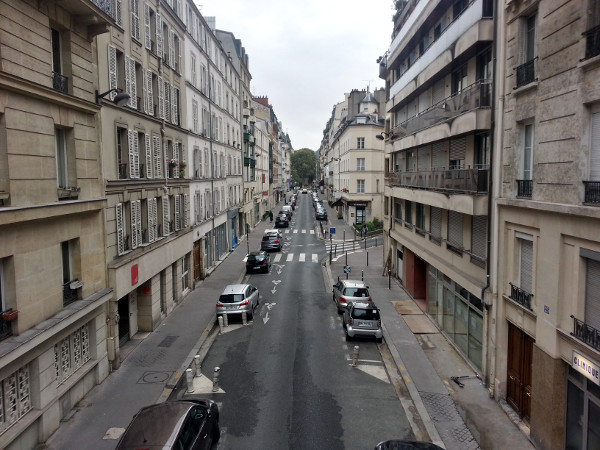
Six-storey streetwalls in Paris (RTH file photo)
Finally, look at the new development zones outside of the historic central cities of places like Paris and Vienna. Dense, modern high-rise towers with mixed-use streetscapes. In North America, we need to add the density where we can: mostly in the city centre, but also along all major thoroughfares city-wide.
The only way to raise our average density is to go tall where we can to make up for the existing stock of low-density housing.
By kevlahan (registered) | Posted March 20, 2018 at 14:13:03
Jason, you yourself argued that we can have high quality densification without towers:
https://raisethehammer.org/blog/362/high...
Now you seem to be arguing that we really do need to build 140 century 21 towers to achieve the right density.
And note that the entire central city of Paris has a diameter of only 10 km including the river (and a population of 2.2 million). In Hamilton, that's the distance from Westdale to Parkdale. And there are lots of other areas that could be densified with mid-rises so it's simply not true that "all properties from Dundas to Stoney Creek" would need to be re-built even if we decided Hamilton needed to quadruple its population.
Comment edited by kevlahan on 2018-03-20 14:14:15
By JasonL (registered) | Posted March 20, 2018 at 17:25:38 in reply to Comment 122642
I wasn't at all saying that we shouldn't have towers. In fact, I wrote a piece back then called "Hamilton should aim higher. Literally".
I was merely combatting the fear-mongering being purported by the home builder at the time who was trying to oppose the city's plan to intensify.
Same thing happening today with ridiculous headlines like "downtown will be a sea of skyscrapers" with new city plan. Just now the fear-mongering isn't happening from the home builders association.
Density comes in many forms, and I welcome them. I love the King William projects by Core Urban, and I welcome TV City. Design matters, not height IMHO
By KevinLove (registered) | Posted March 20, 2018 at 15:06:52 in reply to Comment 122642
Yes, we do need density. But this proposed project has a lot of wasted space that takes away from density. Starting with the fact that two towers are proposed.
Why two towers? This just creates a huge waste of space between the two towers. Why not fill in this space to create a rectangular building? If we look at the aerial photo of the site in Ryan's previous article, we see that there are no less than four high-rise rectangular buildings immediately adjacent to or kitty-corner to this site.
It should be possible to design a building that has the same or more residential units at a much lower height. Just fill in the wasted space.
By JasonL (registered) | Posted March 20, 2018 at 17:27:55 in reply to Comment 122644
personally I prefer narrow, skinny buildings instead of long slabs. Much more sunlight is affected by a long slab. Narrow buildings may cast a slightly longer shadow in the non-summer months, but for not as long a period of time.
Also, one could argue that much of the space being wasted on this site is found by preserving the mansion and turning the parking lot in front of it into a public plaza/parkette.
Give me tall, narrow towers anyway if it makes it profitable to save a heritage building AND add public gathering space which is sorely needed all over downtown.
By Locke (registered) | Posted March 21, 2018 at 14:47:11 in reply to Comment 122649
I too prefer the skinny buildings instead of a long slab for the same reasons you present (glad to find common ground).
I'll also add that after having watched the city's video of the planning meeting and seeing Jason Thorne's tweets from the 19th, I suspect the actual hight limit of this particular property might actually be about 22-storeys under the draft Secondary Plan (and I believe it is 12 without exemption under the old plan).
I'd personally prefer to see two narrow towers that break the plane of the escarpment than a monolith that maxes out at 22-storeys.
That said, I still want the towers to be somewhat relational to the other towers around them and the streetscape to be relational to the the immediate neighbours to the west. And I want to make sure we don't just say yes to developers wanting ever taller buildings which reduces the overall demand for new development elsewhere downtown.
One other note from watching the city's planning committee meeting video: Brad lamb indicated he wants/expects to settle before this goes to the OMB and if you can read between the lines at all, that certainly sounds like he will be hoping to compromise.
My guess, they will negotiate down before the OMB, there will be street wall changes and a total reduction of 15-storeys from the two towers but that the project will still break the escarpment plane.
By KevinLove (registered) | Posted March 21, 2018 at 10:39:46 in reply to Comment 122649
I will not comment on the aesthetics of the design, as everyone will have a different opinion. However, in terms of function, I disagree with the assertion that the plans for the mansion and public plaza will create wasted space. As shown on the renderings, the plaza appears to be useful public space. See:
http://www.lambdevcorp.com/tvcity.php
However, the space between the towers does not appear to have any use. That I will call wasted space.
Similarly, the setback from the sidewalk appears to be counter-productive for retail. What is useful is to have large windows right next to the sidewalk so that people can see what goods are for sale. So-called "window shopping." And to have doors directly onto the sidewalk. That way, people who are walking or cycling by can see what is for sale and go directly into the shop to buy it.
What is extremely inconvenient and annoying is to have retail set back from the sidewalk so that: 1) I need binoculars to determine what is being sold, and; 2) I am inconvenienced by having to haul my body and all the stuff I bought back and forth across the setback.
It is OK to have a small setback of 2 metres to provide for cycle parking. Everyone wants to park their bike right next to the shop door. That's just convenient. But any distance greater than that is a nuisance.
Comment edited by KevinLove on 2018-03-21 10:42:26
By JasonL (registered) | Posted March 21, 2018 at 14:14:34 in reply to Comment 122671
the DNA website actually states that creating new public greenspace/gathering spaces in their hood, and protecting heritage sites is a priority.....
By RobF (registered) | Posted March 20, 2018 at 15:57:47 in reply to Comment 122644
There is a debate about lot coverage vs height, and trade-offs with each approach.
Ideally, we'd be less binary and think about what they each achieve given the context. But I don't agree that open space between buildings is simply wasted space ... it often is, but it doesn't have to be. The reality is that most towers-in-park buildings from the 1960s could use the space around them better ... that moat of grass around them is seldom landscaped well or open to actual use, so it is really just a green roof for the underground parking it conceals.
I find this whole debate odd ... lower Manhattan in the late 19th century had some of the worst living conditions and highest densities in modern urban history, but no high-rises. The problem wasn't strictly scale, lot coverage, or height, but unit density and household density and how that related to access to light and ventilation (i.e. over-crowding and unhealthy conditions). See: http://gvshp.org/blog/2016/04/11/tenemen...
As an aside, the knee-jerk aversion to "density" is somewhat of a lingering effect of the "slum" tenement building and a creeping tendency toward environmental determinism in how we think about urban space and urban social problems.
Vancouverism ... especially the tower on a low-rise podium was intended to be a hybrid that gives you the best of both. Like all things it works as long as people are sensible and don't turn it into a mindless formula. The odd exception to a pattern enlivens things. Too many exceptions and you have a muddle. And not everywhere needs or can "fit" a tower. It depends on the context ...
Comment edited by RobF on 2018-03-20 16:01:32
By JasonL (registered) | Posted March 20, 2018 at 17:29:06 in reply to Comment 122645
again, I find myself agreeing with you....seems like the only space we disagree on is the difference (I don't think there is any) between a 30 storey building and a 40 storey building.
By RobF (registered) | Posted March 20, 2018 at 18:24:33 in reply to Comment 122650
We are coming at it a little differently ... I've spent time at OMB hearings and tend to see this as having a cumulative effect in terms of the ability of the City to regulate height and density. The discussion might evolve post-OMB depending on how the LPAT influences things.
By JasonL (registered) | Posted March 20, 2018 at 21:19:59 in reply to Comment 122654
makes sense....and yes I agree with you there. Which is why I'm actually hopeful for this OMB case and the precedent it should set downtown. Lol... different angle than you're taking I realize, but we both agree there is a cumulative effect.
By fmurray (registered) | Posted March 20, 2018 at 21:15:29
Thank you, Nicholas.
I have to take issue with this statement: "It's frustrating to see people who already have homes in our city trying to prevent other people from moving in. This is one of the biggest problems underway in Hamilton today: people who already own their nice luxury condo or Victorian home trying to block others from moving into their neighbourhood."
This is pure ridiculousness, and is not true in the Durand and DNA (although you don't mention us by name, Jason). We are already the densest neighbourhood in the city and we have learned that we have to deal with developers from the beginning. We have all rented in our lifetimes, and one of our board members is renting currently. We would love to have more tenants on our board and are working towards that goal.
Design matters, and not everyone thinks Brad Lamb's vision is "beautiful". In fact, many think the buildings are pure ugly. But one of the important aspects is how the buildings interact with their surroundings and the interaction with the street. We are not all enamoured with Lamb's vision of having retail tucked underneath the towers.
So when should we put our comments forward? When shovels are in the ground? Too late!
It's amazing to me that three groups: The NA, the Design Review Panel and Planning Staff have all questioned various aspects of the design, but those in other neighbourhoods - Kirkendall and Strathcona see it as OK to criticize their fellow Hamiltonians in favour of a Toronto developer's vision. Allow the development to go ahead, shut up or you are just NIMBY! That phrase NIMBY is used as a weapon, and I've learned that people who use it have stopped listening.
FYI, there was a lot of feedback from tenants in buildings around 163 Jackson, but a revealing comment at Planning Committee told the story about why there may have been few written comments: The addresses on the notices to the surrounding apartments used previous tenants' names -- they were working from an old list, so many of the notices were not read and ended up in the garbage. Some tenants arranged a meeting with the Councillor last year to discuss their concerns. Facts are important to report the whole story.
By ergopepsi (registered) | Posted March 21, 2018 at 11:10:33 in reply to Comment 122657
The DNA only represents the people on the DNA and no-one else. Same with any 'NA'. You can't just start a group and claim to represent your neighbourhood. I'd like to see city council explicitly state that a neighbourhood association represents only those (12) people in that association. It needs to be made clear. You were not elected. You do not represent most of the people in Durand. If an individual or a business allows you to represent them then fine. Otherwise cool the power trip.
By surly (registered) | Posted March 21, 2018 at 10:53:31 in reply to Comment 122657
"one of our board members is renting currently" what's the number of renters versus homeowners in Durand? Shouldn't there be more renter representation?
By fmurray (registered) | Posted March 21, 2018 at 12:46:50 in reply to Comment 122673
Yes, as I said, we are trying to reach out to residents in apartment buildings. If you have a solution for that, let me know.
By fmurray (registered) | Posted March 22, 2018 at 12:05:54 in reply to Comment 122676
I should clarify that I was talking about board members, one being a tenant (but all of us having been renters throughout our lives). We do represent many renters as members of the DNA. Also, paid membership is not necessary if tenants (or anyone) approach the Association for information or advice.
We would like more outreach into apartment buildings and are working on this goal with a city staffer. The locked doors are a challenge.
The DNA is resident-led and all board members are volunteers.
By KevinLove (registered) | Posted March 21, 2018 at 10:14:59 in reply to Comment 122657
We are not all enamoured with Lamb's vision of having retail tucked underneath the towers.
Why not? Sorry, I don't understand this. I can understand concerns about the type of retail. For example, I understand wanting a grocery store.
But no retail at all? Please be so kind as to unpack the nature of this concern.
By fmurray (registered) | Posted March 21, 2018 at 12:45:39 in reply to Comment 122670
Yes, we want retail/commercial space - for sure. But the design shows retail entrances behind columns and underneath the towers, instead of opening onto the street as called for in the city's Tall Building Guidelines.
By JasonL (registered) | Posted March 22, 2018 at 12:32:23 in reply to Comment 122675
I would suggest reading through the detailed drawings Lamb has made available on his website. The 4 retail spaces in this project are probably the nicest retail units in the lower city. Full windows facing the sidewalk, with sidewalk entrances from Hunter. The ceilings are 23 feet high. This is slightly higher than the rooftop of the Pinehurst Mansion.
For comparison sake, the AGH pavilion is 18 feet high ceilings.
Retail won't be 'tucked' away in this project. It will be THE feature for all pedestrians, cyclists and drivers heading through this area. Stand next to Pinehurst and then envision ceiling heights that high all along the Caroline/Hunter streetscape. The lobby and retail units will be grand.
By JasonL (registered) | Posted March 20, 2018 at 21:22:28 in reply to Comment 122657
you're well within your rights to voice your concerns. I'm glad to live in a country where that is allowed and encouraged. I'm simply voicing my view too. I happen to think his design is stunning. But I realize others disagree. I'm cool with that.
Durand is not a dense neighbourhood whatsoever by world standards. And even if it was, there never comes a point where one can expect to wall off their neighbourhood from new investment. NYC and Brooklyn have some of the densest hoods in North America and they keep getting more dense. We have a LONG way to go before we worry about being 'too dense'.
By fmurray (registered) | Posted March 21, 2018 at 09:05:27 in reply to Comment 122660
Again, you're not listening.
I did not say Durand is "too dense", or "densest in the world". It IS the densest neighbourhood in Hamilton. And we welcome new development, and in fact will be happy when there are residents living where the CH "spaceship" currently takes up space. We are not walled off, not in the slightest. There's that scream of NIMBY! again. Stop saying that, and maybe you will hear valid concerns.
All of the above can be true, and at the same time we would like to have the developer listen to our concerns and perhaps put aside his hate for podiums in order to create a good pedestrian experience. And 618 units on .4 hectares is too much. It's too much in the opinion of Design Review Panel and Planning Staff and the NA, and the immediate neighbours to the east and west of the site.
One tower would be sufficient on that site.
By JasonL (registered) | Posted March 21, 2018 at 09:17:21 in reply to Comment 122666
according to development standards Canada-wide, that site can absolutely host 2 buildings. I would love to hear valid concerns on this project. So far the only one that resonates with me is the sterile looking streetscape in the renderings. However, having looked through the detailed drawings of the site plan, I realize that some of the brightest and nicest retail space in Hamilton is planned for the street-front. The architect rendering just doesn't show it well.
By RobF (registered) | Posted March 21, 2018 at 10:51:37 in reply to Comment 122667
Toronto uses a 25 metre minimum separation between towers as a standard ... just like our new DTSP and zoning will require. So no it can't host 2 buildings above 44 metres in height as proposed. To my knowledge there are no development standards Canada-wide with respect to this ... just best practices that take the form of guidelines or zoning requirements.
By rednic (registered) | Posted March 21, 2018 at 18:49:29
I'm interested why is the word affordable is not mentioned your article? Are these just the unfortunates that can be moved on to Brantford when the time comes ? A successful city is inclusive ( or does that only count for social policies)
By JasonL (registered) | Posted March 21, 2018 at 21:17:32 in reply to Comment 122684
this isn't an affordable housing project. It's a privately built, market-rate complex. A successful city is inclusive....and provides new investment of both affordable and market-rate housing.
You must be logged in to comment.
There are no upcoming events right now.
Why not post one?